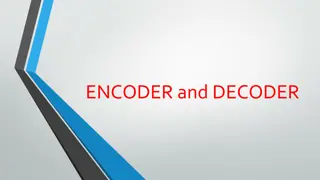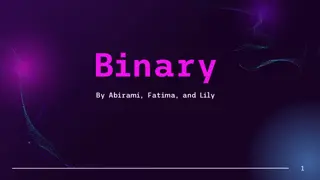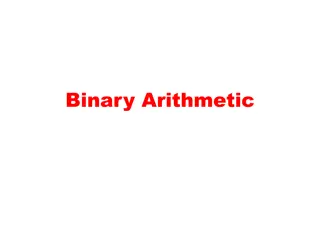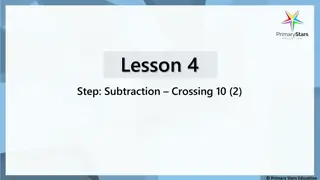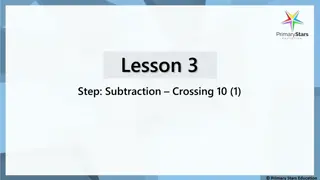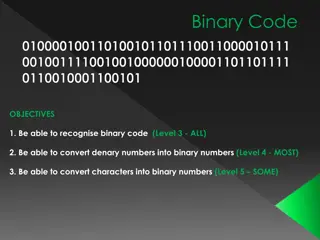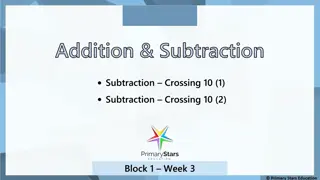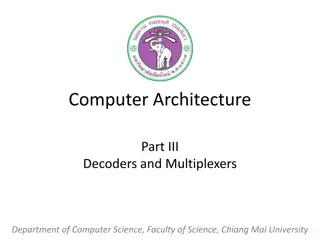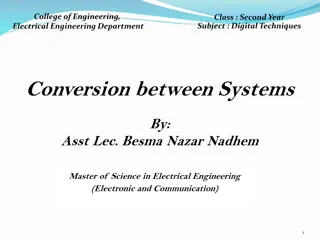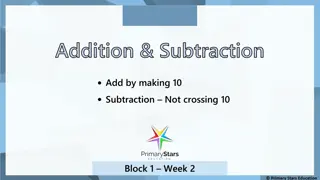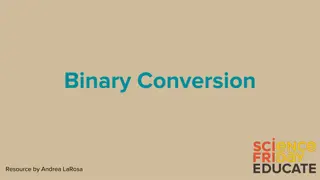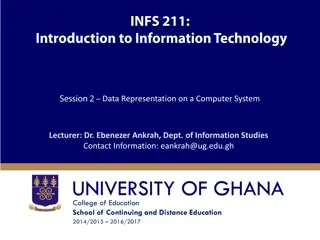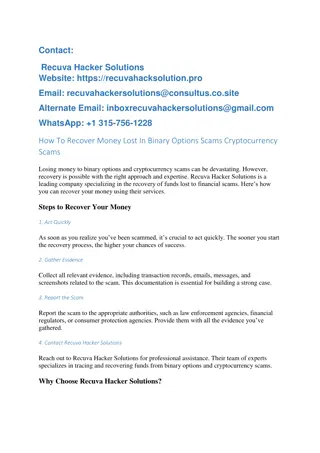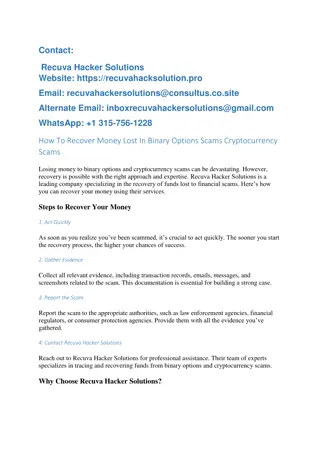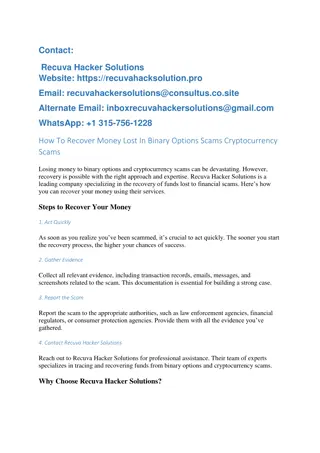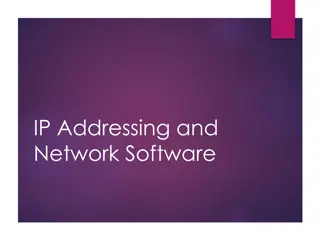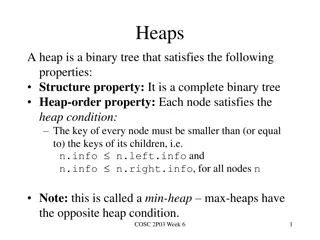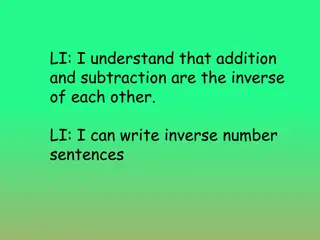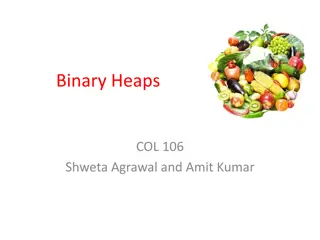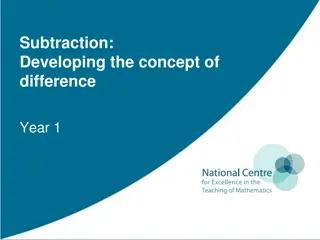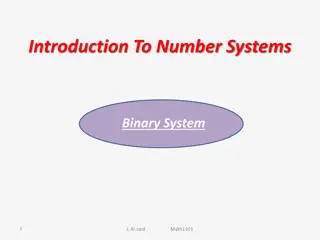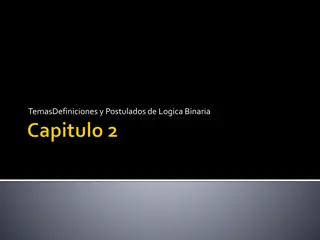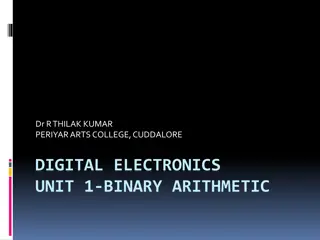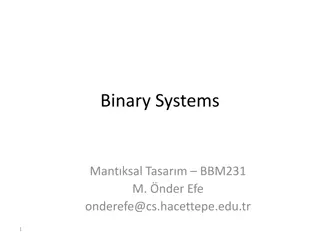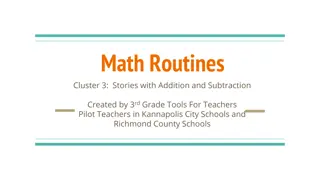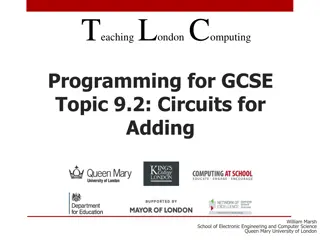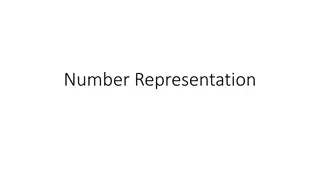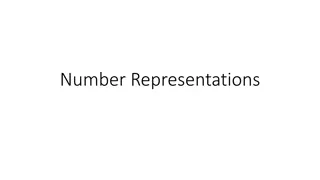Understanding Binary Codes and Their Applications
Binary coding is crucial for digital systems as they understand only 0s and 1s. This process converts information into binary language for processing by digital circuits. Different types of binary codes like weighted codes and BCD codes are used for error correction, digital communication, and compu
7 views • 20 slides
Understanding Encoder and Decoder in Combinational Logic Circuits
In the world of digital systems, encoders and decoders play a crucial role in converting incoming information into appropriate binary forms for processing and output. Encoders transform data into binary codes suitable for display, while decoders ensure that binary data is correctly interpreted and u
4 views • 18 slides
Understanding Binary Counters and Types of Counters
Binary counters are registers used to count clock pulses, while binary counters follow the binary number sequence. There are two types of counters: serial/asynchronous counters and parallel/synchronous counters. Serial counters change output flip-flop to next flip-flop, requiring minimal hardware bu
11 views • 21 slides
Understanding Non-Weighted Codes and Excess-3 Code in Binary Systems
Explore non-weighted binary codes like Excess-3 code, learn how to convert decimal numbers to XS-3 code, advantages and disadvantages of BCD codes, and steps to convert Excess-3 code to binary. Discover the intricacies of binary coding systems with practical examples.
5 views • 55 slides
Understanding Binary Number System and its Applications
Explore the world of binary numbers with insights on what binary is, its significance in computing, conversion methods between binary and decimal, hexadecimal number system, and binary arithmetic operations. Dive into the foundations of digital communication through the language of zeros and ones.
0 views • 24 slides
Binary Arithmetic
Explore the world of binary arithmetic, including addition, subtraction, multiplication, and division. Learn the rules and examples of performing basic binary operations efficiently. Understand how to convert binary numbers to decimal equivalents. Enhance your understanding with visual explanations
0 views • 51 slides
Understanding BCD and ASCII Arithmetic in 8086 Assembly Language
BCD (Binary-Coded Decimal) and ASCII (American Standard Code for Information Interchange) are key concepts in 8086 assembly language for numerical and character manipulations. BCD Arithmetic involves addition and subtraction techniques using instructions like DAA and DAS. The adjustment instructions
1 views • 21 slides
Math Subtraction Practice for Kids
Engage children in subtraction practice with these interactive exercises. Students complete number sentences by subtracting from a starting quantity, reinforcing the concept of "crossing 10." The fluency tasks include scenarios with counters and objects of different colors to make learning fun and e
1 views • 12 slides
Understanding Combinational Circuits in Computer Architecture
Combinational circuits in computer architecture play a crucial role in transforming binary information from input data to output data. These circuits consist of logic gates connected in a specific arrangement to process binary data efficiently. Key components such as half-adders and full-adders are
1 views • 48 slides
Math Subtraction Fluency Activities for Kids
Enhance subtraction fluency skills with engaging activities involving crossing 10, number lines, and ten frames. Explore varied subtraction scenarios using different numbers and practice problem-solving through visual representations. Assess understanding through interactive story-based questions, e
0 views • 9 slides
Understanding Binary Code and its Conversion
Computers rely on binary code, consisting of 0s and 1s, to communicate. Learn how to recognize, convert denary numbers to binary, and understand the basics of the computer language. Discover how to create a table for conversion and practice converting numbers to binary in this informative guide.
1 views • 26 slides
Math Subtraction Activities and Practice
Explore a variety of subtraction activities, including fluency exercises, problem-solving tasks, and lesson steps focusing on crossing tens and matching bonds to 10. Engage in visual learning with images illustrating subtraction concepts. Test your skills with interactive exercises using number line
0 views • 49 slides
Binary Basic Block Similarity Metric Method in Cross-Instruction Set Architecture
The similarity metric method for binary basic blocks is crucial in various applications like malware classification, vulnerability detection, and authorship analysis. This method involves two steps: sub-ldr operations and similarity score calculation. Different methods, both manual and automatic, ha
0 views • 20 slides
Understanding Decoders and Multiplexers in Computer Architecture
Decoders and multiplexers are essential components in computer architecture, converting binary information efficiently. Integrated circuits house digital gates, enabling the functioning of these circuits. A decoder's purpose is to generate binary combinations, with examples like the 3-to-8-line deco
0 views • 37 slides
Understanding Binary Codes and Self-Complementing Codes
The concept of binary codes, including Binary Coded Decimal (BCD) codes, and self-complementing codes is explored in this informative content. Learn about how decimal numbers are represented in binary form, the structure of BCD codes, and the properties of self-complementing codes like 2421 and Exce
0 views • 34 slides
Digital Techniques for Number System Conversion in Electrical Engineering
Understand how to convert between binary, octal, decimal, and hexadecimal number systems with examples and explanations. Learn the processes of binary-to-decimal, octal-to-decimal, hexadecimal-to-decimal, decimal-to-binary, decimal-to-octal, and decimal-to-hexadecimal conversions. Gain insights into
0 views • 10 slides
Understanding Binary Coded Decimal (BCD) and Excess-3 Code
Binary Coded Decimal (BCD) is a binary code used to represent decimal numbers, with the popular 8421 BCD code and its conversion process explained. Additionally, Excess-3 Code, another BCD code, is detailed with an example of finding its code for a given decimal number. Different BCD codes like 4221
0 views • 11 slides
Introduction to Binary Logistic Regression: A Comprehensive Guide
Binary logistic regression is a valuable tool for studying relationships between categorical variables, such as disease presence, voting intentions, and Likert-scale responses. Unlike linear regression, binary logistic regression ensures predicted values lie between 0 and 1, making it suitable for m
7 views • 17 slides
Interactive Math Lessons for Subtraction Within 20
Engage in interactive math lessons focusing on subtraction within 20 by using the strategy of making 10 and not crossing 10. Practice fluency with subtraction problems and identify number lines accurately. Complete tables and calculations to reinforce understanding. Enhance subtraction skills with f
0 views • 10 slides
Understanding Binary Code and Color Conversion
Delve into the fascinating world of binary code and learn how it works to represent data digitally. Discover the process of decoding binary pulses into colored pixels, using binary sequences to identify colors, and practicing digital-analog conversion through logic maps. Explore the language of bina
0 views • 20 slides
Understanding Data Representation on Computer Systems
Explore how data is converted into binary forms in computer systems, the difference between data and information, binary coding schemes, and the elements of the data hierarchy. Learn about binary digits, bites, bytes, and the essential topics covered in this educational session. Recommended reading
3 views • 25 slides
Binary Options Funds Recovery
Unlocking the Vault: How Recuva Hacker Solutions Leads the Charge in Binary Options Funds Recovery\nIn the world of finance, binary options trading promises lucrative returns with minimal effort. However, the harsh reality is that many individuals fa
0 views • 15 slides
How to Recover Your Money from Binary Options Scam: Ultimate Guide
Binary options trading has gained significant attention in recent years as an easy form of online trading involving stocks, currencies, commodities, and indices. However, with its popularity has come a surge in binary options scams. In 2019 alone, re
0 views • 15 slides
Recover Lost Funds From Binary Options Fraud Brokers
Are you a victim of a binary options fraud? You can fight back and recover your funds. Report to MychargeBack today! We have helped thousand of binary options fraud victims to get their money back. You can get your funds back from binary options scam
0 views • 15 slides
Understanding IP Addressing and Conversion from Binary to Decimal
Learn about IP addressing, including binary notation, dotted-decimal notation, and the process of converting binary numbers to decimal. Explore the unique features of IP addresses and the steps involved in converting binary to decimal systematically.
3 views • 47 slides
Understanding Heaps in Binary Trees
Heaps are binary trees that adhere to specific properties, such as being complete and satisfying the heap-order property. This involves nodes having keys smaller than or equal to their children. Key operations like removeMin and insert can be performed on heaps efficiently. Array implementations all
0 views • 10 slides
Understanding the Inverse Relationship of Addition and Subtraction
Learn about the inverse relationship between addition and subtraction through examples and visual aids. Practice writing inverse number sentences and understand how addition and subtraction are opposite operations that involve rearranging the same numbers in a different order.
3 views • 11 slides
Understanding Binary Heaps: Efficient Data Structure for Priority Queue Operations
Explore the concept of binary heaps, a specialized type of binary tree that allows for quick retrieval of the smallest (or largest) element. Learn how binary heaps excel in finding the minimum value, essential for priority queue applications in operating systems, event simulations, and more. Compare
2 views • 34 slides
Understanding Binary Logic Systems in Documentation
Binary logic systems play a crucial role in documentation for individuals with diverse backgrounds such as management, process designers, operations staff, maintenance technicians, and more. These systems, depicted in binary logic diagrams, provide a clear and concise representation for various prof
4 views • 16 slides
Exploring Subtraction Concepts in Year 1 Math Lesson
Dive into the world of subtraction in a Year 1 math lesson focused on developing the concept of difference. From warm-up activities to representing subtraction with counters, this resource guides you through counting odd and even numbers, understanding take away vs. difference, and extending concept
0 views • 26 slides
Exploring the Binary Number System in Mathematics
Delve into the intricacies of the binary number system with this comprehensive guide. Learn how binary numbers are formed, and master the conversion techniques between binary and decimal numbers. Discover the fascinating world of binary fractions and the algorithms for converting decimal numbers to
0 views • 20 slides
Unveiling the Progenitors of Stripped Envelope Supernovae (SNe)
The mechanism behind the stripping of stripped-envelope SNe remains a key question linked to their progenitors. Various mechanisms such as Single Star Progenitors, Binary Star Progenitors, Stellar Winds, and Close Binary Interactions are thought to dominate the stripping process. Observations of Typ
0 views • 12 slides
Fundamentals of Binary Logic: Definitions and Postulates
Binary logic involves concepts such as closure, associative law, identity element, additive and multiplicative operators, distributive law, and inverses. These concepts define the behavior of binary operators on sets, including addition, subtraction, multiplication, and division in relation to speci
0 views • 8 slides
Introduction to Binary Arithmetic for Digital Electronics
Binary arithmetic is fundamental in digital electronics, involving addition, subtraction, and multiplication of binary numbers. This guide explains the rules and examples of binary arithmetic operations, such as binary addition and subtraction, along with detailed steps and illustrations for better
0 views • 21 slides
Understanding Binary and Numeric Systems in Computing
Delve into the world of binary systems, binary numbers, base conversions, powers of 2, arithmetic operations with binary and octal numbers, and multiplication principles in computing. Learn how to compute values and conversions in various number systems efficiently.
0 views • 41 slides
Math Routines Cluster 3: Stories with Addition and Subtraction
Explore math routines for 3rd-grade students focusing on addition and subtraction concepts. The cluster includes activities like Counting Around the Room, Would You Rather scenarios, and standards for adding and subtracting whole numbers up to 1000. Enhance students' understanding of estimation stra
0 views • 17 slides
Understanding Binary Codes and Character Coding Techniques
Binary codes, such as ASCII and EBCDIC, are crucial in representing data in computers and digital systems. They play a key role in error detection and data encoding. This article discusses the basics of binary coding, various types of binary codes, character coding techniques like ASCII and EBCDIC,
0 views • 22 slides
Understanding Binary Addition Circuits in Computing
Explore the concepts of half adders, full adders, and binary addition circuits used in computer systems. Learn how binary digits are represented as logic levels to perform addition operations. Dive into the working principles of half adders, truth tables, formulas, and circuit diagrams for binary ad
0 views • 15 slides
Understanding Number Representation and Conversion
Learn how to convert between decimal and binary number representations. Discover the process from decimal to binary by dividing repeatedly by 2, and from binary to decimal by summing the powers of 2. Explore the simplicity of converting between base 16 and base 2, and practice binary addition with e
0 views • 27 slides
Understanding Binary Representation of Numbers with Fractions
Learn how to represent numbers with fractions in binary form. Discover the process of converting real numbers, like 5.75, into binary by separating the integer and fraction parts. Explore the method of obtaining the binary representation of the fraction through division by specific decimal values. U
0 views • 21 slides

